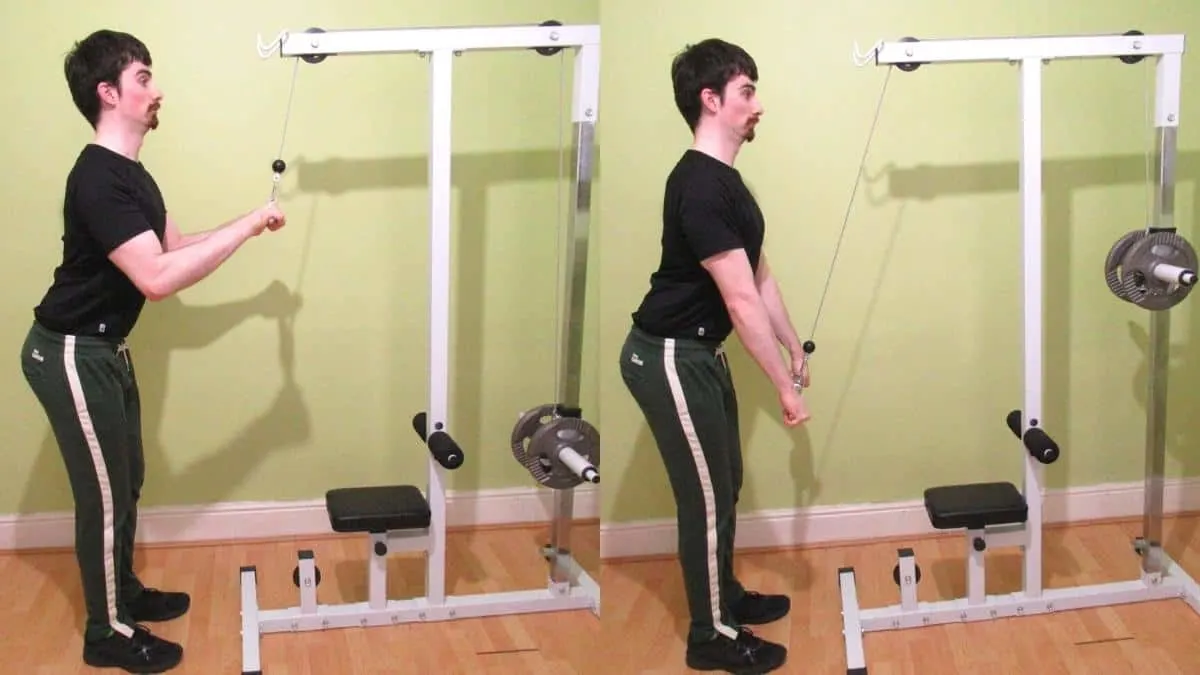The straight bar tricep pushdown is an excellent exercise for building your upper arms because it enables you to overload your triceps with plenty of resistance.
As noted in our tricep rope vs bar pushdown comparison, you can lift heavier weights during straight bar pushdowns because bar attachments require less stabilization than rope attachments.
The only real downside of the straight bar cable pushdown is that it forces your hands into an extreme amount of pronation.
This pronation can cause wrist pain and discomfort when the weights get heavy, in which case the EZ bar pushdown is a suitable replacement because EZ bars have joint-friendly semi-pronated grips, which more or less keep your wrists out of trouble.
Straight bar pushdown exercise details
- Also Known As: Straight bar cable tricep extension, overhand tricep pushdown
- Main Muscles: Triceps brachii
- Exercise Type: Strength
- Exercise Mechanics: Isolation
- Difficulty Level: Beginner
- Equipment Needed: Cable machine, straight bar attachment
How to do straight bar pushdowns
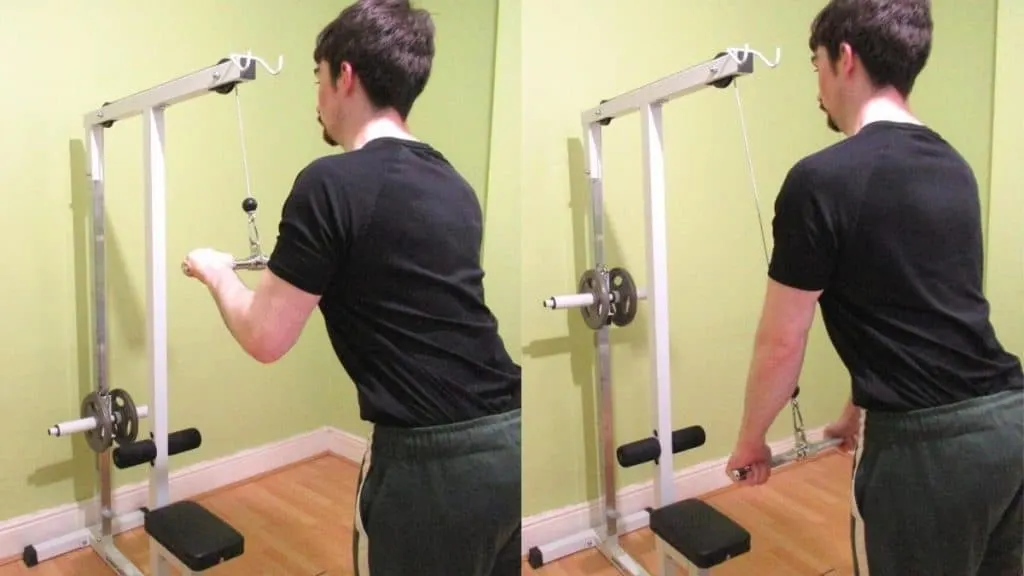
- Connect a straight bar attachment to a high pulley and then grab the bar with a pronated grip.
- Take a few small steps away from the machine and bend over slightly.
- Tighten your core, stick your chest out, and ensure that your back isn’t rounded.
- Pin your elbows into your sides, and then flex your triceps to push the bar down.
- Keep going until your elbows are fully locked out.
- Squeeze your triceps forcefully at the bottom of the rep.
- Release the contraction in a controlled manner.
- Raise the bar until your forearms touch your biceps, then perform your next rep.
- Perform 3-5 sets of 8-15 reps in total.
Straight bar pushdown variations
Here are 5 types of straight bar triceps pushdowns that you can perform to add variety to your training routine and work your triceps from different angles.
Reverse grip straight bar cable extension
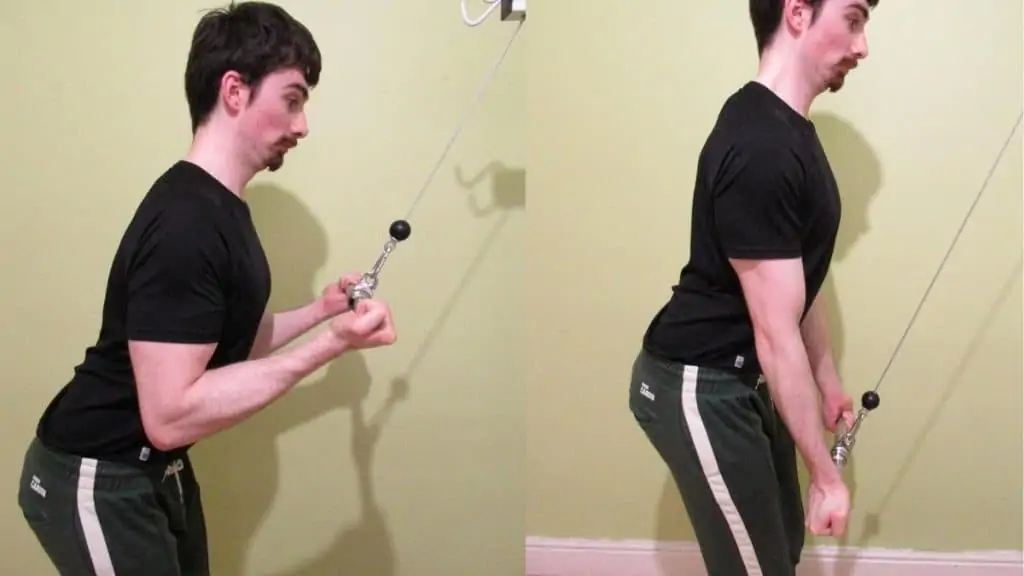
The reverse grip tricep extension is virtually the same as the straight bar push down in terms of lifting technique; the only difference is that you’re using an underhand grip rather than an overhand grip.
Many lifters report feeling an intensified triceps peak contraction when they perform the reverse straight bar pushdown.
This is because it’s easier to keep your elbows close to your sides when you use a reverse grip, which in turn makes the long head of the triceps more contracted (the more extended your shoulder is—i.e., the further it is behind your torso—the more contracted the long head becomes).
Using a reverse grip for the straight bar pressdown can also help to alleviate much of the wrist discomfort associated with the exercise.
The trade-off for being more comfortable, however, is that you won’t be able to lift as much weight because when your triceps are more contracted, which they are when you use a reverse grip, they’re also a bit weaker. This goes for any muscle.
Of course, your triceps don’t understand what “weight” is; they just respond to tension. So even though you’ll need to lighten the resistance for the reverse pushdown, that doesn’t mean that your triceps will be receiving less stimulation.
Kneeling straight bar triceps pushdowns
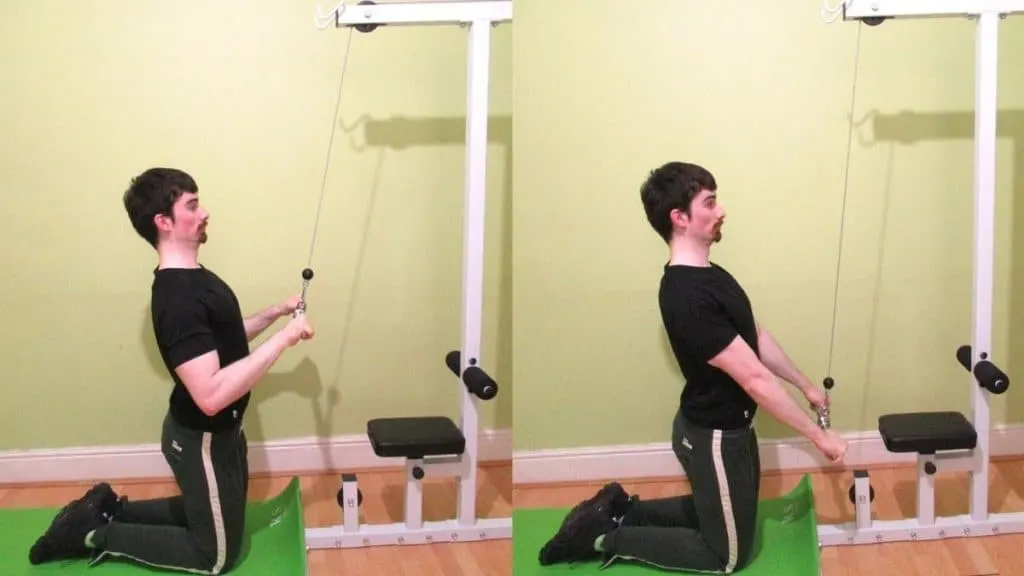
The kneeling tricep pushdown is the ideal exercise if you’re using a small cable machine or if you just happen to be really tall.
Since your arms are further away from the pulley when you’re in a kneeling position, the cables naturally have to travel further, which means that they exert more force on your triceps during the first part of the rep.
In a regular standing straight bar pushdown, on the other hand, there isn’t usually much tricep tension during the first few inches of movement if you’re training on a small machine because the weight stack is barely elevated.
Kneeling pushdowns also have the added benefit (depending on your point of view) of giving your abs a good isometric workout. This extra abdominal activation will undoubtedly increase your core strength if you perform the exercise frequently, but it may also make it harder to focus on training your triceps, especially if you have a weak mind-muscle connection.
Seated straight bar push down
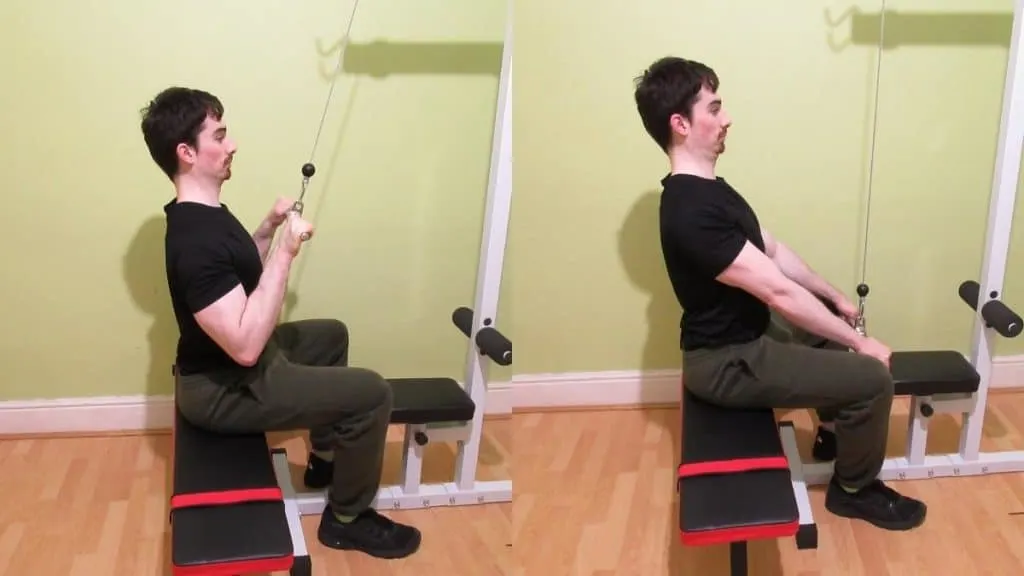
If you want to completely isolate your triceps by eliminating momentum from the movement, then the seated tricep pushdown is a great choice because when you’re sat down, you can’t use your legs to cheat.
You can do the seated cable bar pushdown on an incline bench or on a flat bench.
The incline bench version feels more like a tricep extension than a pushdown because your arms are way out in front of your body. This shoulder positioning naturally means that the incline version works the long head more than the flat bench variation because the long head is the only triceps muscle that acts on the shoulder joint.
The flat bench variation is essentially like a regular straight bar cable pushdown, but instead of standing up, you’re sitting on a weight bench so that you can focus purely on training your triceps.
When you’re sat down, you don’t have to brace your abs as hard, which in turn helps you to establish a stronger mind-muscle connection with your triceps.
Isometric straight bar cable press down
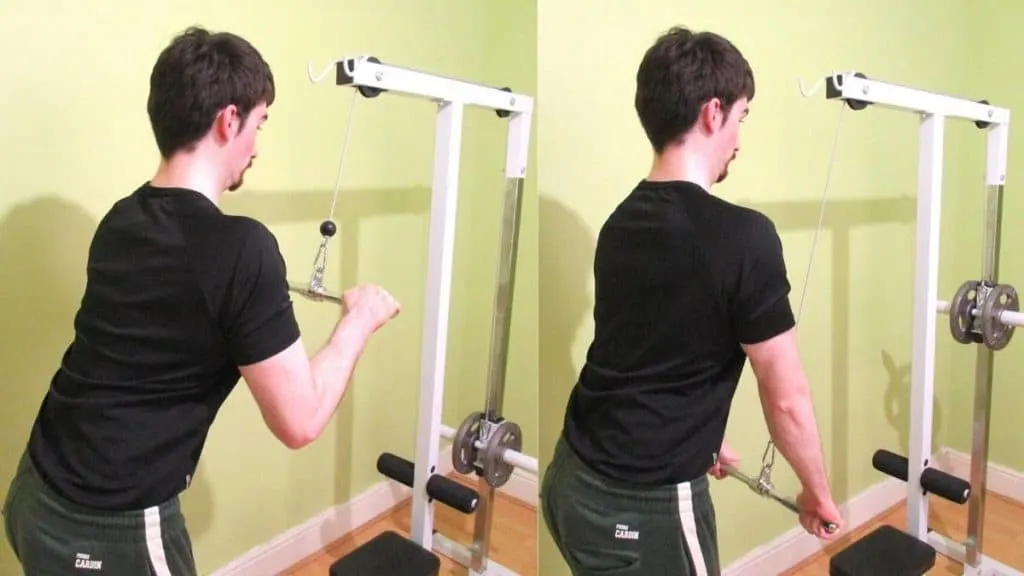
The isometric tricep pushdown is an underrated exercise but one that can really enhance the quality of your triceps mind-muscle connection.
Many lifting enthusiasts avoid locking out their elbows during the overhand cable pushdown either because the weight is too heavy or because they’ve been told to keep constant tension on their triceps.
But what muscle do you think is locking out the weight during a straight bar pushdown?
Elbow extension is the main function of the triceps. So it’s not like you’re taking the tension off your triceps when you train them optimally by achieving full elbow extension.
Knowing the importance of using a full range of motion for stimulating triceps hypertrophy, the isometric straight bar cable extension is effective for increasing your pushdown lockout power and improving your mind-muscle connection.
To get the most from this movement, I suggest lightening the weight and then performing 8-10 reps with a 3-5 second isometric hold at the bottom of each rep.
Stability ball straight bar cable pushdowns
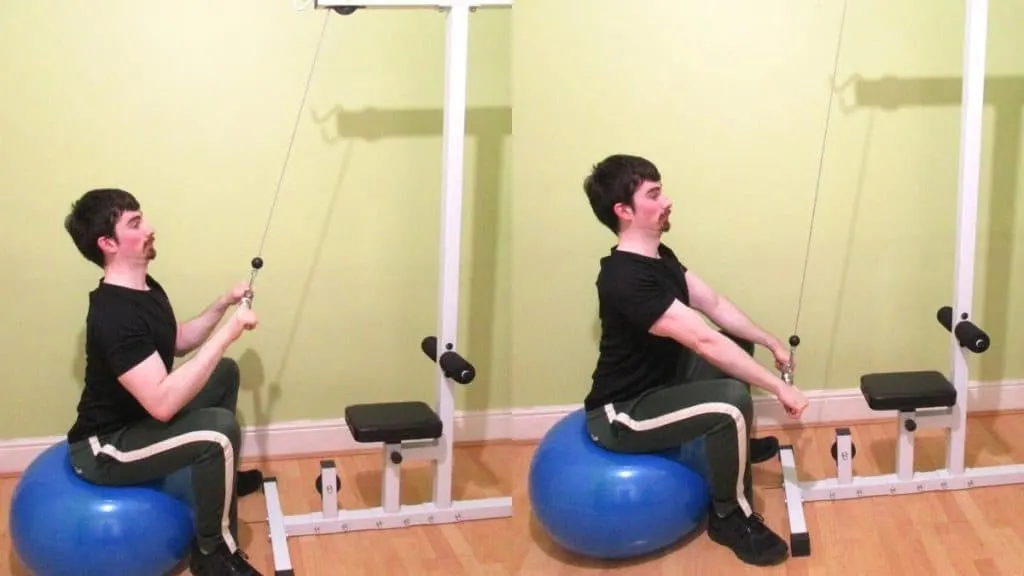
At a glance, the stability ball triceps pushdown looks virtually identical to the seated version that you saw above.
But they’re actually very different exercises.
The stability ball pushdown works your core to a much higher degree than the seated pushdown because you’re sitting on an unstable surface, which naturally means that your abs have to contract harder in order to keep your body stable.
Of course, if you just want to work your triceps, then you’re best off sticking with the seated or standing pronated tricep pushdown because it requires less core strength and stability.
Straight bar cable pushdown pros and cons
Learn the pros and cons of straight bar tricep pushdowns to see what the exercise can and can’t do for your triceps.
Pro: Ideal for lifting heavy
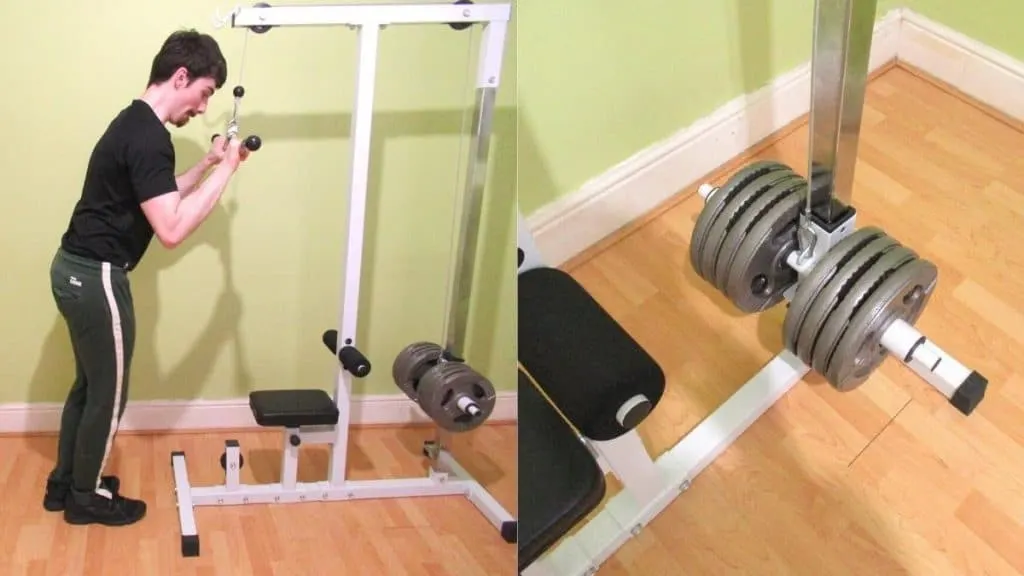
Like the v bar pushdown, the straight bar cable pushdown requires less stabilization than the rope pushdown because bar attachments are easier to balance (with a rope, you have to lift each side of the rope independently).
The reduced stability requirement of the exercise means that you can push heavier poundages and overload your triceps with ample amounts of resistance so that they grow bigger and stronger.
Getting stronger at straight bar pushdowns will also increase your compound pressing strength (think bench press and overhead press) because, during a press, the triceps are responsible for locking out the weight, which is to say extending your elbows.
When you’re able to lift heavier weights, you’re also able to provoke more hypertrophy because, all else being equal, heavier weights provide a more potent hypertrophic stimulus than lighter weights.
So for building maximum mass and developing powerful pressing strength, performing tricep pushdowns with a bar is an excellent idea.
Pro: Offers multiple grip options
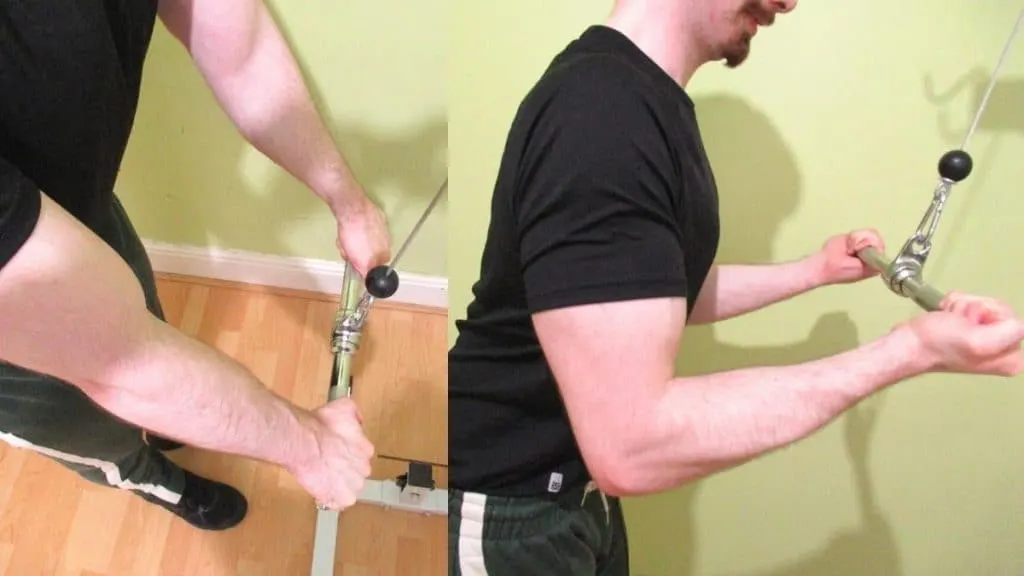
The straight bar press down is deceptively versatile. Don’t like the overhand tricep pushdown?
No problem, you can use a reverse grip instead.
Need help keeping your elbows close to your sides?
Narrow grip tricep pushdowns are your best bet.
Want to intensify the peak contraction?
Go for the rocking tricep pushdown (admittedly, a rope is better for this exercise).
These are just a few examples in addition to the 5 straight bar pushdown variations already mentioned.
There’s no right or wrong way to perform the straight bar tricep pushdown in terms of grip. Try multiple hand positions to find out which grip is most comfortable for you.
If all the grips are equally comfortable, go with whichever one enables you to lift the heaviest weights.
Pro: Great for getting a pump
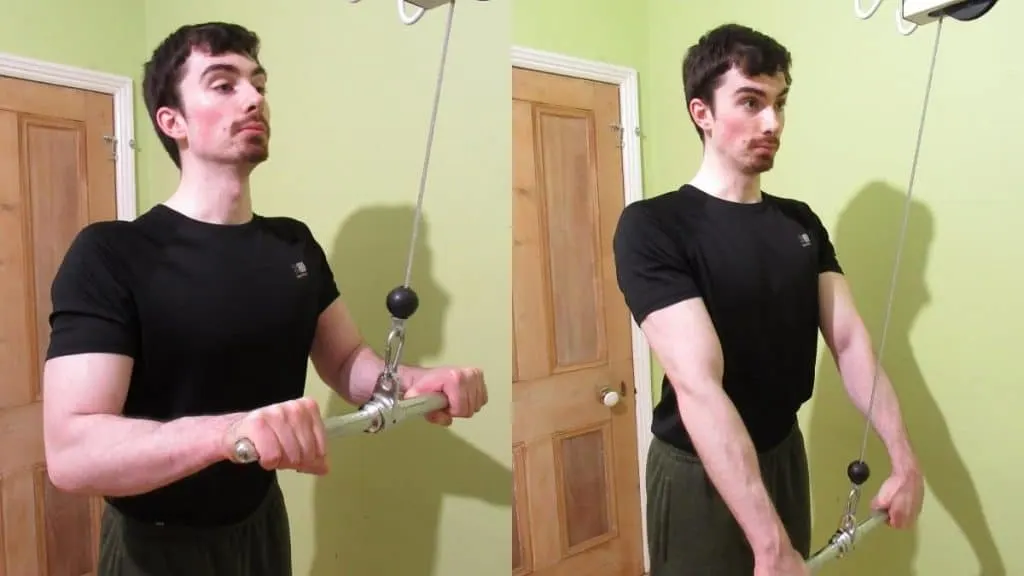
Performing a tricep straight bar pulldown is great for getting a pump because cables challenge your triceps with constant tension.
From the moment that you lift the weights off the stack, it’s down to your triceps to control the resistance. As such, even when your joints are locked out, the pulley is still exerting some kind of force on your triceps.
So since your triceps don’t get a chance to rest until the set is over, they naturally get rewarded with an intense pump, which will make your arms look bigger and more vascular while you’re lifting.
If you want to maximize your pump, stick to sets of 12-20 reps. Then, once you reach failure with full reps, perform partial reps to fatigue the remaining stubborn muscle fibers and burn out your triceps.
Con: Could hurt your wrists
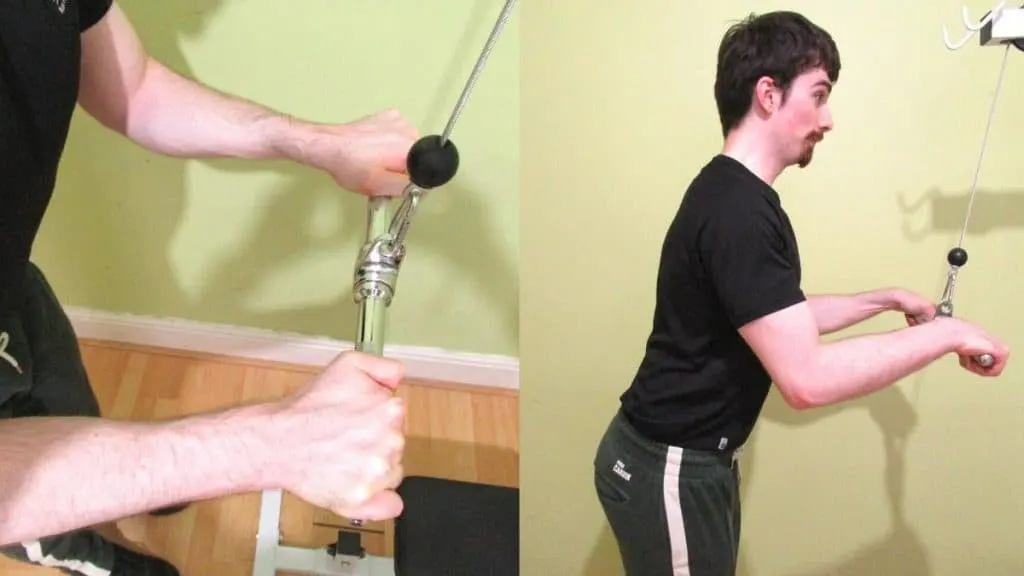
Performing a tricep pushdown with a straight bar enables you to lift plenty of weight in order to stimulate hypertrophy and strength development. And because the resistance is cable-based, the exercise is typically easy on the elbows as well.
Yet, because straight bar pressdowns force your hands into full pronation, the exercise can also be very harsh on the wrists, especially as the weights start to get heavier.
You can get around this wrist pain problem to an extent by doing the straight bar push down—for high reps—at the end of your workout when your triceps are already fatigued.
Since you’ll naturally be lifting lighter at the end of your session, there will be less torque going through your joints, which means that your wrists won’t feel as much discomfort.
In this regard, doing a wide grip cable tricep pressdown, which helps you to keep your wrists in line with your shoulders, can also help to alleviate joint discomfort.
Con: May lead to tricep size asymmetries

Any kind of bar-based exercise runs the risk of causing muscular imbalances. This is because when you lift the same training implement with both arms, there’s always a chance that your stronger side will dominate the movement.
Tricep size asymmetries make your arms look less aesthetic and can cause the barbell to become lopsided during your compound presses, which further exacerbates the imbalances.
The solution is to perform every straight bar cable press down rep with the best possible form.
Push the bar down with equal amounts of force from both arms.
As you’re lifting, picture your triceps (especially you’re weaker triceps muscle) flexing and stretching under the resistance. This will strengthen your mind-muscle connection and ensure that your triceps are controlling the weight during every part of the rep.
Conclusion: Should you do tricep pushdowns with a straight bar or not?
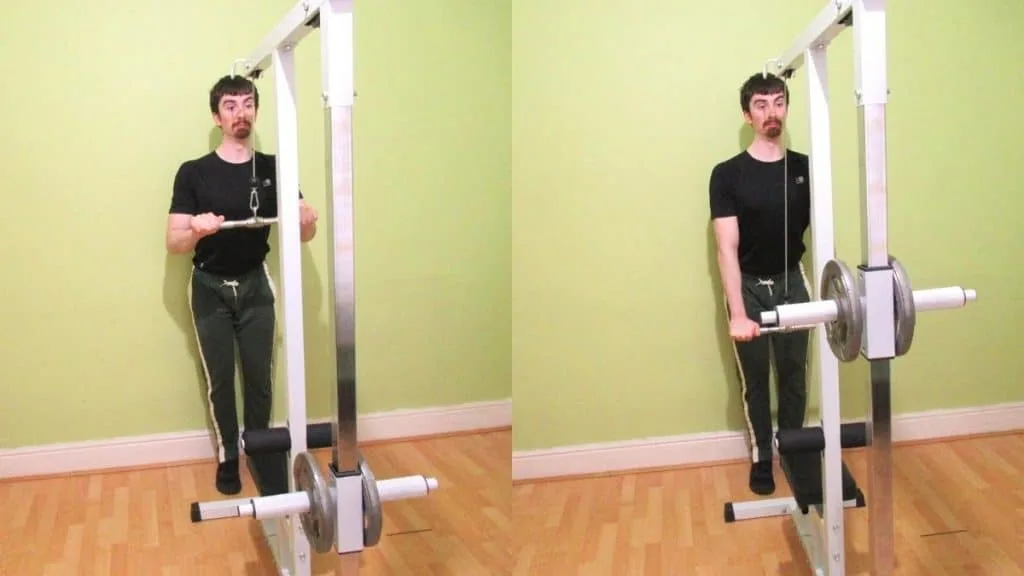
Straight bar pushdowns are an effective mass-building exercise for the triceps because they’re highly conducive to heavy lifting and progressive overload.
While the straight bar cable pushdown can cause wrist discomfort for some lifters (which you can sidestep by using an underhand grip), it still has excellent muscle-building potential. This is because straight bars are more straightforward to stabilize than the likes of a tricep rope, meaning that you can generate more force and thus lift heavier.
If you don’t have access to a cable machine, then you can learn the best way to do tricep pushdowns at home instead. It’s possible to mimic straight bar triceps pushdowns with minimal equipment. But if you have a cable machine, then nothing beats the constant tension of the straight bar cable tricep extension.

